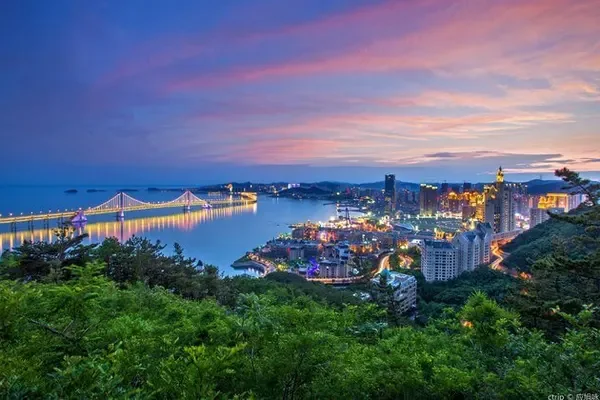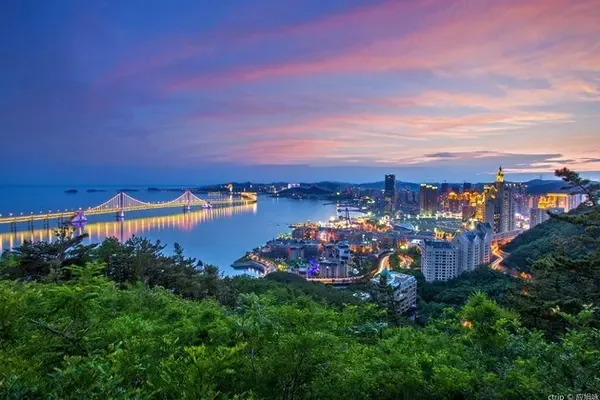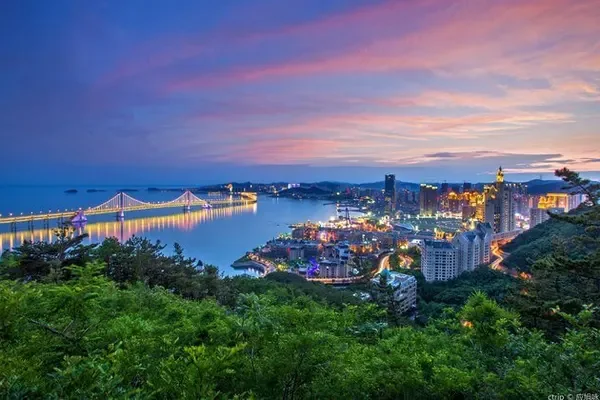The miraculous and perfect Jiaohe City, where the ruins are still alive. Eastern Pompeii still exists today? Don't complain that the yellow sand has gone to the trace. --Inscription
"Climbing the mountain during the day to watch the beacon fire, drinking horses and crossing the river at dusk. Pedestrians fight against the wind and sand, and the princess's pipa is full of resentment." Li Qi, a poet of the Tang dynasty, saw soldiers drinking horses and looked back at the flames of war. It is difficult to see the difficulties of Jiaohe City during the Han and Tang Dynasties.
The brutal war gave this once prosperous town a desolate and tragic color. Finally one day, it collapsed and turned into ruins, a perfect ruin.

Jiaohe Ancient City is located about 11 kilometers west of Turpan City, Xinjiang. The river is called "Jiaohe" because the river divides into two parts and then meets in the south of the city after going around the city. According to the "Hanshu Biography of the Western Regions", "The former state of Cheshi, Wang Zhijiaohe, the river flows down, so it is called Jiaohe."

Jiaohe Ancient City was originally the capital of Cheshi State in the Western Regions. It used to be one of the most prosperous cities on the ancient Silk Road, as famous as Loulan, known as the "Oriental Pompeii City". During the Wei, Jin, Southern and Northern Dynasties, a large number of Han people from the Central Plains and the Hexi Corridor moved to Turpan to escape the war. Jiaohe once became a place where the Han nationality gathered.




In the second half of the thirteenth century, Mongolian nobles invaded. In 1383, Jiaohe City perished in the flames of war and became a "deserted site". By the Yongle period of the Ming Dynasty, it had been completely reduced to ruins.


In 1993, hundreds of Chinese and foreign archaeologists carefully peeled off the dust with small shovels and small brushes. This long scroll of history written by the loess slowly unfolds lonely and tenaciously. One by one, the historical puzzles that have been troubled for many years have gradually found their answers.
The ancient city of Jiaohe was built by Cheshi people, about 2000 to 2300 years ago, which happened to be in the Qin and Han Dynasties of our country. The old city is composed of temples, government offices, towers, dwellings and workshops.
Contrary to building from the ground, Jiaohe Ancient City is a city that develops from top to bottom. Most buildings are directly digging walls and rooms in the original soil, and even the streets and alleys are dug bit by bit. This is called "reducing the land and leaving the walls", and it is the only one in China.
The ancients forcibly pulled out a city inch by inch on a loess platform with ravines and ravines. From another perspective, the ancient city of Jiaohe is actually a large-scale loess clay sculpture, carved by the ancestors collectively.
Due to the drought and lack of rain, the ruins are well preserved. It's like a fine piece of porcelain that still shines after being broken into pieces.

Jiaohe Ancient City is by far the largest, oldest and best-preserved adobe city in the world, and is known as "the most perfect ruin in the world". In 1961, it was identified as a national key cultural relic protection unit, and in 2014, it was included in the "World Heritage List".
Panlong Crouching Tiger High Mountain, Jiaohe Ancient City is magnificent, precipitous and dangerous. Because of this, since the 19th century, its mysterious legend has attracted a large number of domestic and foreign explorers and archaeologists to come here for treasure hunting and archaeological revelation.

The ancient city of Jiaohe looks like a big ship heading southeast, and like a willow leaf falling with the wind. As a small defensive city, all buildings along the street have no doors or windows, and only by detouring through alleys can one enter the house.
"Reduce the land and keep the walls, and build houses from the top down" is a miracle. In addition, Jiaohe Ancient City has two miracles.
One is that there are only two gates in the east and south. The south side is the main gate, and the towering cliff body is split open to become the South City Gate. Today, the original building has disappeared, leaving only a huge gap for tourists to enter and exit. Entering by the mouth, it is the central street with a width of 11 meters and a length of 340 meters. Embedded 6 to 7 meters underground, the thick raw soil layer facing the street is the tall wall. The east gate was cut by the river day and night, blocked on the cliff and existed in name only.
Another strange thing is that the ancient city of Jiaohe faces cliffs on three sides and is surrounded by water on four sides. The old city is surrounded by a river about 30 meters deep. The river valley is about 1,700 meters long and 300 meters wide at its widest point.
When it was built, military defense was taken as the guiding ideology of its architecture, and the entire ancient city was a huge military fortress, reflecting the fierce ethnic and social contradictions in this area in history.

In the era of cold weapons, the torrential river is a natural barrier to stop the enemy. The country of Cheshi, which is rooted in Hexinzhou, firmly positions itself in the role of defense. It's a pity that even if they firmly occupy the favorable terrain, Jiaohe City still can't stop the flames of war again and again. It has suffered so many wars that it cannot be counted, and it has become a battlefield with "many skeletons on the ground".
In the long period of more than 1600 years, Jiaohe City has had a war almost every two or three years, and there has been a war every ten years or so. Sovereignty of the city changed hands again and again. Cheshi, Gaochang, Tubo, and Mongolia successively became the masters here.
The Western Han Dynasty and the Xiongnu fought a tug-of-war for half a century in the Jiaohe area, known as the "Five Fighting Car Divisions" in history.
In 62 BC, the Western Han Dynasty headed by Emperor Xuan finally drove away the Xiongnu and took control of Jiaohe. The illustrious military exploits of many civil servants and generals were all established in Jiaohe City: Li Guangli, Li Ling, Zhao Puonu, Zheng Ji, Ban Chao...
But the Huns were not willing to give up easily. In 450 AD, they besieged Jiaohe when King Cheshi led his troops to assist the Northern Wei Dynasty in sending troops to Yanqi. The king's son fought hard for 8 years, and finally had to go to Yanqi because of the exhaustion of food and grass in the city. In this way, Cheshi State was destroyed, and Jiaohe was merged into Gaochang.
Being between the big man and the Huns, like a mouse in a bellows, is the greatest misfortune for the Cheshi people. They have to play the role of "repeated villain". In the Western Han Dynasty alone, they returned to and carried back the Han several times.

There are 20 noble tombs left in Cheshi Kingdom. In 1994, archaeologists excavated two of them.
What is puzzling is that there are often no bones of the tomb owner in such a large and luxurious tomb. Some experts analyzed that when the country was ruined and the family was in ruins, the Cheshi people hurriedly opened the ancestral tombs, carried the bones, and wandered far away. How tragic and helpless this is.
However, the most frightening thing is a cemetery for infants and young children. The remains of more than 200 infants and young children were buried there. The oldest was no more than 10 years old, and the youngest was only a newborn baby.
According to textual research, this was the time when the Che Shi Kingdom was destroyed, and in order to prevent the descendants of the kingdom from falling into the hands of the enemy, he did it cruelly. Some experts also believe that it may have suffered from a plague at that time.

During the Zhenguan period (627-649 A.D.), the Great Tang army swept across the Western Regions, ghosts blocked and killed ghosts, and Buddhas blocked and killed Buddhas. First conquered the Eastern Turks, then pacified the Gaochang State that was attached to the Western Turks, and established Xizhou (now Turpan), and then conquered Yanqi, Qiuci, Shule and Khotan.
So far, Tianshan South Road has all been included in the Chinese territory. In 640 A.D., the Tang Dynasty set up the highest military institution in Jiaohe City - Anxi Duhufu, making it a strategic hub in the middle of the Silk Road.
The ruins of Jiaohe Ancient City that tourists see today reflect the organizational system and layout of the Tang Dynasty. That is to say, in the Tang Dynasty, it underwent a lot of expansion and transformation.
The war promoted the integration of various ethnic groups in the Western Regions and accelerated the advancement of civilization, but it was also the black hand that destroyed civilization.
No one can tell exactly how many ethnic groups have lived in the Western Regions. In the Turpan Basin alone, there are more than 10 recorded in history books: Cheshi, Xiongnu, Hujie, Xianbei, Rouran, Gaoche, Turkic, Tubo, and Uighur. , Mongolia... The ins and outs of many ethnic groups are still a mystery. Jiaohe Ancient City is the best witness of the great integration of nationalities and the great convergence of cultures.

At noon on July 26, 2017, we left the "enthusiasm" Huoyan Mountain and came to the ancient city of Jiaohe where we thought it would be cooler.
We really think too simple. It coincides with the hottest July of the year, and it also coincides with the hottest noon of the day. The golden light pierced the eyes, and the whole person seemed to be dried out at any moment.
What is even more frightening is that there is no place in the entire old city that can be completely shaded. We, who just broke out from the sweating of the Flame Mountain, seemed to have lost our way, and turned back to the original place, and were grilled on the charcoal stove. That sweat is really "sizzling" and dripping out.
I even think this place is even more flaming than the flaming mountain. It is said that tourists suffer from heat stroke every day. Someone still walked in vertically and carried them out horizontally. We can't appreciate the thickness under the scorching sun, we can only rush through the city like a steam room, but we don't want to miss any corner.

There are no words in the barren hills, the earth is silent, only the sun is enthusiastic, spreading its wings and rushing towards every inch of the ruins of Jiaohe City, making the old city built of loess more desolate and dignified.
The scorching sun of six or seven hundred years has already evaporated all the water in the old city. There are no birds and insects, only ruins, and tourists who keep shouting "hot, hot" like cicadas.

As far as the eye can see, there are dilapidated broken walls, collapsed fortresses, damaged pagodas, and weeping temples... They are either falling or leaning, or leaning or standing, and the air seems to be filled with thick loess and a touch of blood. taste.
The hunting banners at the top of the city in the past, the long bells in the lobby of Buddhist temples, the curling smoke in the courtyards of residents, the sound of camel bells in the city streets...all were swept away by the long wind of the years.

Surprisingly, on the dry loess on both sides of Zhongxin Street, there are several clumps of green plants crawling. Blossoming pale yellow flowers, looking up at the scorching sun with a smile, added a touch of vitality to the ancient city that has gone through Cangsang.
We plucked up our courage and walked to the end of Jiaohe Ancient City against the heat wave. Looking down, thinking about the longness of the world and lamenting the insignificance of the individual. The seemingly invincible city has long since been destroyed, and even the torrent that flows around the city has been rubbed into a stream of clear spring by the years. Only the patches of Populus euphratica are still in high spirits.

Should we lament the ruthlessness of the years, or admire the wisdom of the ancients?


